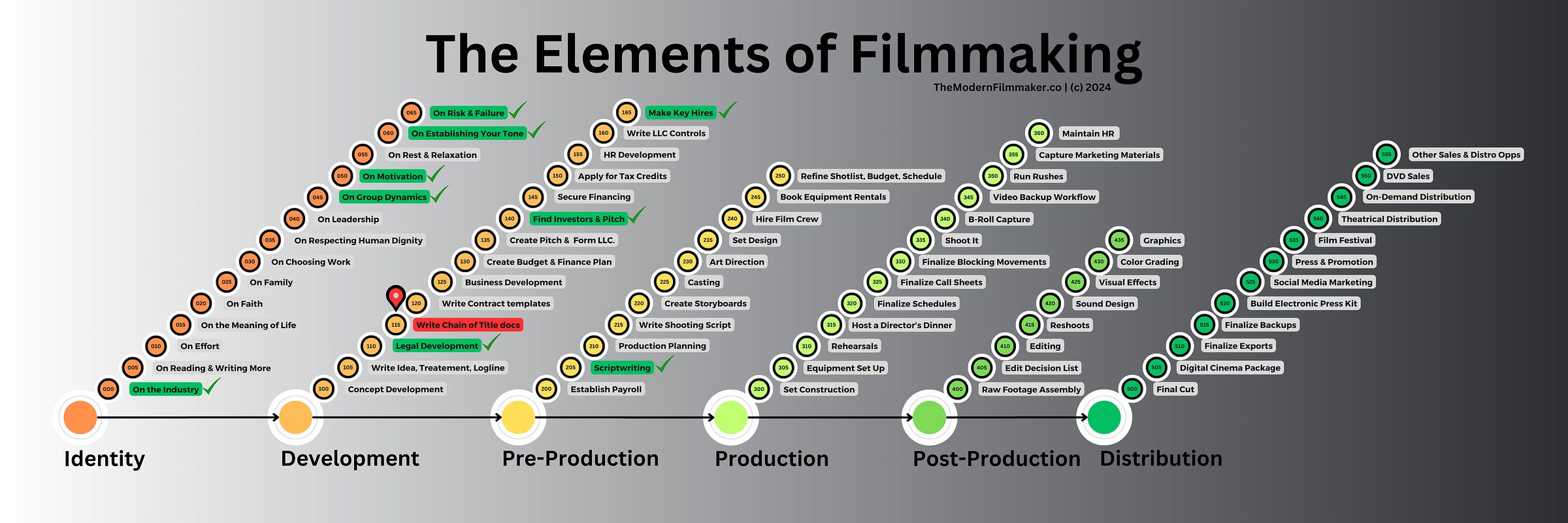Cover Your Ass & Your Films with this One Document…
Learn why a Chain of Title document is crucial for filmmakers to secure legal ownership of your story, avoid disputes, and protect your creative rights.
From a cold Fall night.
November 8th
Hey Filmmaker,
The road from script to screen is full of potential roadblocks, and for filmmakers, one of the most critical but often overlooked documents is the Chain of Title.
This document essentially “proves ownership” of a story, ensuring that all rights have been legally transferred and clarified from concept to production.
Not only is this essential to sell or distribute a film, but it’s also the ultimate “CYA” (Cover Your Assets) measure for preventing legal issues.
In this blog post, we’ll explore why establishing a Chain of Title early in the development process is essential, examine how some famous films suffered without one, and introduce you to a solution—my Chain of Title Template, designed to make this process smoother for filmmakers.
THE MODERN FILMMAKER
This Issue: Cover Your Ass & Your Films with this One Document…
Last Issue: Why a Lean Film Crew is Your Secret Weapon To Make Better Movies.
On Sale Now: The Modern Filmmaker’s On Set Filmmaking Dictionary.
So There I Was…
Working as a producer on a mid-sized indie film that was generating a lot of buzz.
We had just wrapped up production, and spirits were high.
Everything was set for post-production, and we even had a few studios interested in distribution.
But as the legal team began reviewing our documents, an issue cropped up: nobody could find proof that the original story rights had been secured.
Turns out, the writer and director had a verbal agreement, which the director assumed was enough.
They were friends, after all.
But when it came time to show documentation proving ownership of the story, we were empty-handed.
The writer had decided he wanted to renegotiate the deal, delaying production by months as contracts were drawn up and signed retroactively.
Not only did this nearly derail the project, but it also put a damper on everyone’s morale and strained relationships.
This experience taught me that a Chain of Title document isn’t just a formality; it’s a crucial step in protecting a project legally and professionally.
With a formal Chain of Title in place, filmmakers can avoid costly delays, disputes, and miscommunication.
So, let’s dive into why this document matters and how it can protect your production.
What Is a Chain of Title Document?
A Chain of Title document is a record that details the legal ownership of a creative work from its original author through every transaction, sale, or assignment.
Think of it as a documented trail of every agreement, copyright transfer, and contract that proves, without question, that you have the right to make the film and sell it.
For filmmakers, this document is vital because it shows that you have the legal right to bring the story to screen and that no one else has claims to the idea.
It covers screenplays, underlying books, adaptations, short stories, and any other source material used for the project.
Without a clear Chain of Title, even the most compelling film might never see the light of day.
Distributors, investors, and studios will avoid involvement if they feel a project’s rights aren’t clear.
Why the Chain of Title Document Matters for Filmmakers
Legal Protection from the Start
One of the primary reasons for having a Chain of Title document is legal protection.
Without it, your project is vulnerable to disputes over ownership, copyright claims, or worse—lawsuits.
The Chain of Title clarifies all rights in writing, offering concrete proof of ownership for each stage of development.
Take, for instance, the film Coming to America.
Paramount was hit with a lawsuit after the release because an unknown writer claimed the story had been stolen from a treatment he submitted to the studio years before.
With a clear Chain of Title, Paramount could have pointed to their documentation to quickly address and settle the dispute.
Essential for Funding and Distribution
Investors and distributors require confidence in your project’s ownership before they contribute financially or take on distribution rights.
The Chain of Title acts as a legal safeguard that shows all rights have been obtained, clearing a pathway for funding, distribution, and partnerships without legal headaches.
If you don’t have a solid Chain of Title, studios won’t touch your project, and streaming services won’t consider it either.
This makes it indispensable for securing the partnerships that can take your film from indie darling to international sensation.
Protects Against Potential Copyright Claims
In today’s media landscape, intellectual property disputes are common.
Without a clear Chain of Title, it’s difficult to prove you haven’t infringed on someone else’s work.
Lawsuits related to copyright or ownership can derail a project, as in the infamous case of Avatar, where James Cameron faced numerous copyright lawsuits claiming parts of the story and concepts were stolen.
Whether or not the claims are valid, defending against copyright allegations is a long, costly process.
Having a Chain of Title document is a strong deterrent, signaling that all rights are documented and legally sound.
Makes Rights Transfer Simple and Clear
With a Chain of Title document, transferring rights to a new producer, studio, or distributor becomes seamless.
This document serves as a clear roadmap, detailing all past rights and transfers, which reduces ambiguity and cuts through red tape.
Streamlines Future Projects and Adaptations
Let’s say you’re producing a film based on a short story.
Without a Chain of Title in place, any subsequent adaptations, spin-offs, or sequels will require revisiting and re-negotiating rights.
But if you create and maintain a thorough Chain of Title, you won’t need to jump through these hoops in the future.
🎬 Take the Next Step in Your Filmmaking Journey
Filmmaking is daunting—you know the vision in your head, but turning it into reality feels impossible without clear guidance and tools.
Imagine having a front-row seat to a movie being made and walking away with all the templates, resources, and inspiration you need to make your own.
The WITH LOVE All-Access Pass is your ticket to demystifying the filmmaking process, offering an unparalleled behind-the-scenes experience and every resource in one bundle.
Examples of Chain of Title Issues in Famous Films
Several well-known films have run into major setbacks or legal issues due to insufficient Chain of Title documentation:
The Terminator: James Cameron and Gale Anne Hurd’s iconic film faced challenges when author Harlan Ellison filed a lawsuit alleging the film was based on his Outer Limits episodes. The lack of initial documentation almost stopped the franchise before it could start.
The Lord of the Rings: The film rights for Tolkien’s work were notoriously complex, with decades of disputes over various adaptations, films, and merchandise rights. Proper Chain of Title documentation might have streamlined the adaptation process, avoiding costly delays.
Frozen and Zootopia by Disney: Both films encountered lawsuits from plaintiffs claiming their ideas were copied, leading to public disputes and legal costs. Clear documentation could have demonstrated legitimate ownership and origin, potentially preventing these complications.
Establishing a Chain of Title might seem overwhelming, but my Chain of Title Template simplifies the process.
Designed for filmmakers, this template includes a structured layout for documenting all rights, transfers, and permissions involved in your project.
With step-by-step prompts, you can ensure that each element is covered—from initial concepts to final production.
This template not only makes it easy to compile and organize your documentation, but it also presents it in a professional format, ready for investors, legal advisors, and distributors.
Whether you’re creating an indie film or a blockbuster, my Chain of Title Template provides the legal framework you need to keep your project safe and successful
Why a Chain of Title Matters for Filmmakers
To sum it all up, here are the top reasons a Chain of Title is essential for every filmmaker:
Avoid Legal Disputes: Prevent costly battles over ownership or copyright issues.
Secure Funding and Distribution: Give investors and distributors confidence in your project’s legal standing.
Protect Intellectual Property: Safeguard your project against copyright claims or lawsuits.
Streamline Rights Transfer: Easily transfer rights if your film is picked up by a major studio or distributor.
Save Time and Money: Prevent delays and costs associated with legal disputes and document reviews.
Ensure Long-Term Project Viability: Keep your project protected, allowing for adaptations and spin-offs.
Final Thoughts
The film industry is rife with legal complexities, and a Chain of Title document is the single most powerful tool to ensure your story is yours alone.
This document can mean the difference between a film that thrives and one that’s lost to legal limbo.
Don’t risk your creative work; take control of your project’s future by establishing a strong Chain of Title early in development.
If you want to get your hands on the Chain of Title document template that I use, click here to grab it today.
Cheers,
Mike Rekola
P.S. Catch up on the rest from TheModernFilmmaker.co:
👉 Buy: The Modern Filmmaker’s On Set Filmmaking Dictionary, today.
👉 Some Filmmakers to Know: Gina Prince-Bythewood
👉 Some Filmmaking Terms: Above-the-Line & Back to First Marks…
👉 Some Stories: So there I was… With a Filmmaker Who Lost It All…
👉 Some Thoughts: Show Don’t Tell Works…
👉 Meet Me: Mike Rekola…






